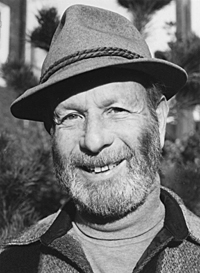
Dr. Edgar Wayburn was a five-term president of the Sierra Club and one of America's most effective (and least known) wilderness advocates.
A native of Georgia who began his medical practice in San Francisco, where his mother had grown up, Dr. Wayburn became a Sierra Club member in 1939 so he could join the Club's trips to the Sierra Nevada. Gradually, he became more involved in conservation issues, beginning with the expansion of Mt. Tamalpais State Park from a mere 870 acres to more than 6,000 acres.
He also spearheaded the establishment of Point Reyes National Seashore, the first national park unit of any size near a major metropolitan area. That would be followed by the formation of Golden Gate National Recreation Area, which would tie together nearly all the open space in south and west Marin, and even some lands in San Francisco and beyond, including the city's beaches, Alcatraz and the Presidio. All told, it amounts to some 200,000 acres. No other city in America—perhaps the world—has anything that can compare with it.
When the National Park Service opposed Dr. Wayburn's plan for the Golden Gate National Recreation Area, favoring the establishment of a much smaller park instead, Nixon's Secretary of the Interior Rogers Morton was called upon to testify before the Senate Interior Committee. No great fan of environmentalists, Morton surprised everyone by supporting the Sierra Club's proposal in full. Morton told the shocked hearing: "The Park Service wants me to support their plan, but I went out there to the site with my friend Dr. Wayburn, and he convinced me otherwise."
For all his accomplishments, Ed Wayburn was never a full-time conservationist. A practicing physician and a family man, he dedicated his spare hours and weekends to the health of the planet. Neither was he well known, even within the environmental movement, having never gained the wide recognition of such contemporaries as David Brower and Ansel Adams. The low profile suited him fine. Dr. Wayburn preferred to do his work quietly, behind the scenes. He was a born facilitator and diplomat, someone who exuded the kind of authority and integrity that gets people—even powerful people—to listen.
Dr. Wayburn may have been a diplomat, but he was never keen on compromise. Where others might have been content to save random parcels of land—whatever scraps could be spared by the agents of so-called progress—he wanted nothing less than the protection of whole watersheds. As he explained in his memoir, Your Land and Mine (Sierra Club Books, 2004), "It wasn't enough simply to add a few acres here and there; nature doesn't divide herself into measured plots. A watershed encompasses the chain of life; if any part is developed, the integrity of the whole ecosystem is threatened."
That devotion to ecological principles guided him through many subsequent wilderness campaigns, including the decades-long struggle to found, and later expand, Redwood National Park. Years of travel in the Alaskan backcountry with his wife Peggy—herself a prominent wilderness advocate—led eventually to his crowning achievement: Passage of the 1980 Alaska National Interest Lands Conservation Act, which created ten new national park units and effectively doubled the size of America's National Park system. When Dr. Wayburn was awarded the Presidential Medal of Freedom in 1999, President Clinton said of him, "He has saved more of our wilderness than any person alive."